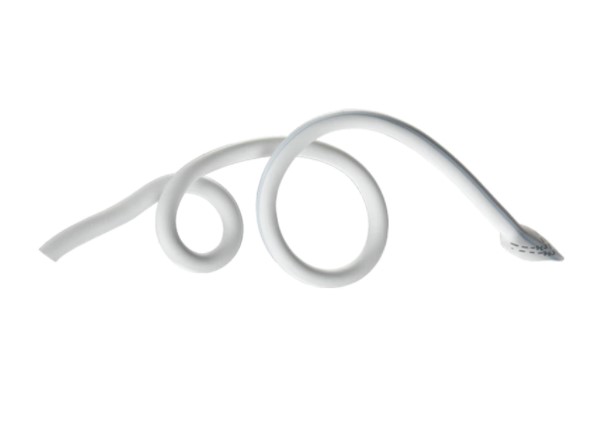Indications for Use
VENAFLO® II Vascular Grafts in Straight, Stepped, CENTERFLEX™, and Stepped CENTERFLEX™ configurations are indicated for use as subcutaneous arteriovenous conduits for blood access only.
Contraindications
None known.
Warnings
1. All VENAFLO® II ePTFE vascular grafts are supplied sterile and nonpyrogenic unless the package is opened or damaged. VENAFLO® II grafts are sterilized by ethylene oxide. Each graft is intended for single patient use only. DO NOT RESTERILIZE.
2. This device has been designed for single use only. Reusing this medical device bears the risk of cross-patient contamination as medical devices – particularly those with long and small lumina, joints, and/or crevices between components – are difficult or impossible to clean once body fluids or tissues with potential pyrogenic or microbial contamination have had contact with the medical device for an indeterminable period of time. The residue of biological material can promote the contamination of the device with pyrogens or microorganisms which may lead to infectious complications.
3. Do not resterilize. After resterilization, the sterility of the product is not guaranteed because of an indeterminable degree of potential pyrogenic or microbial contamination which may lead to infectious complications. Cleaning, reprocessing and/or resterilization of the present medical device increases the probability that the device will malfunction due to potential adverse effects on components that are influenced by thermal and/or mechanical changes.
4. Do not use after expiration date printed on the label.
5. Do NOT cannulate the externally supported portion of any VENAFLO® II ePTFE vascular graft due to the risk of beading embolization and/or pseudoaneurysm.
6. DO NOT REMOVE THE EXTERNAL SPIRAL BEAD SUPPORT FROM ANY CENTERFLEX™ CONFIGURED GRAFT. Attempts to remove the beading may damage the graft. If damage occurs, discard the graft. 7. VENAFLO® II grafts do not stretch (are non-elastic) in the longitudinal direction. Failure to cut the graft to an appropriate length may result in anastomotic or graft disruption, leading to excessive bleeding, loss of limb or limb function, and/or death.
8. Aggressive and/or excessive graft manipulation when tunneling, or placement within a too tight or too small tunnel, may lead to separation of the spiral beading and/or graft breakage. DO NOT pass the cuff portion (venous end) of the VENAFLO® II graft through a tunneler sheath or the tissue tunnel, as this could lead to separation of the spiral beading and/or graft breakage.
9. When embolectomy or balloon angioplasty catheters are used within the lumen of the graft, the inflated balloon size must match the inner diameter of the graft. Over-inflation of the balloon or use of an inappropriately sized balloon may dilate or damage the graft.
10. Avoid repeated or excessive clamping at the same location on the graft. If clamping is necessary, use only atraumatic or appropriate vascular smooth jawed clamps to avoid damage to the graft wall. Do not clamp the cuffed portion of the graft.
11. Exposure to solutions (e.g., alcohol, oil, aqueous solutions, etc.) may result in loss of the graft's hydrophobic properties. Loss of the hydrophobic barrier may result in graft wall leakage. Preclotting of this graft is unnecessary.
12. Avoid excessive graft manipulation after exposure to blood or body fluids. Do not forcibly inject any solution through the lumen of the graft, or fill the graft with fluid prior to pulling it through the tunnel as loss of the graft's hydrophobic properties may occur. Loss of the hydrophobic barrier may result in graft wall leakage.
13. Do NOT expose VENAFLO® II grafts to temperatures greater than 500°F (260°C). PTFE decomposes at elevated temperatures, producing highly toxic decomposition products.
14. After use, this product may be a potential biohazard. Handle and dispose of in accordance with accepted medical practice and applicable laws and regulations.
15. During tunneling, be sure to create a tunnel that closely approximates the outer diameter of the graft. A tunnel that is too loose may result in delayed healing and may also lead to perigraft seroma formation.
16. Care should be taken when cannulating the graft for dialysis access; avoid the cuff area and the CENTERFLEX™ external support, properly rotate cannulation sites, and use proper compression to achieve hemostasis during post-cannulation care.
Precautions
1. Only physicians qualified in vascular surgery techniques should implant this prosthesis. The healthcare provider is responsible for all appropriate postoperative care instructions to the patient.
2. The healthcare provider must observe aseptic technique during implantation, postoperatively, and during cannulation.
3. When suturing, avoid excessive tension on the suture line, inappropriate suture spacing and bites, and gaps between the graft and host vessel. Failure to follow correct suturing techniques may result in suture-hole elongation, suture pull-out, anastomotic bleeding and/or disruption. Refer to "Suturing" for further instructions.
4. Do not cannulate the cuffed portion of the graft. For further instructions, refer to the "Blood Access" section.
5. Consider intraoperative and postoperative anticoagulation therapy for each patient as appropriate.

